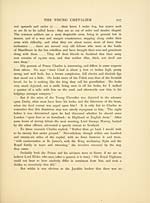Stuarts
(300) Page 226
Download files
Complete book:
Individual page:
Thumbnail gallery: Grid view | List view

226 THE STUARTS
behaviour is immortalised in the song known as "Johnnie Cope" written
by a Haddingtonshire farmer :
Fie now, Johnnie, get up and rin,
The Highland bagpipes mak' a din ;
It is best to sleep in a hale skin,
For 'twill be a bluidy morning.
When Johnnie Cope to Dunbar came
They speer'd at him, "Where's a' your men?"
"The deil confound me gin I ken,
For I left them a' in the morning."
On the eve of the battle of Preston Pans the Prince was content to
dine upon some coarse broth, and the meat from which it was made, at a
little inn of "the village of Tranent. He, with the Duke of Perth and
another officer, had only two wooden spoons and a butcher's knife between
them, as the landlady had concealed her pewter service for fear of the
Highlanders. This is but one instance of many which might be given of
the Young Chevalier's indifference to ceremony, and his cheerful endurance
of the trials and hardships of a campaign. When the troops were outside
Edinburgh they were with difficulty prevailed upon to sleep otherwise
than in the open air, and Charles, who came daily to review his hardy
mountaineers, sometimes passed the night in the camp, lying down without
taking off his clothes.
After Preston Pans things looked serious for the Hanoverian cause.
Marshal Wade, considered the best officer that England then could boast
of, declared Scotland was lost ; and Horace Walpole did but give expression
to the feeling of dismay which seized many minds when he wrote that he
should have to leave Arlington Street for some wretched garret in
Herrenhausen, and perhaps be reduced to give lessons to the young Princes
at Copenhagen. Troops were recalled in haste from Flanders, and placed
under the command of the Duke of Cumberland. The surrender of Carlisle
was another triumph for the Stuart cause, and Derby was reached on
December 4.
A certain Henry Bradken, a practiser of Physic in Lancaster, as he
styles himself, has described his impressions of the Young Chevalier and
his forces in a letter to Sir E. Fawkener, which is preserved in the State
Paper Office. He writes from Warrington, December 4, 1745. After
premising that he "knew all their (the Jacobite) goings-on in 1715," he
estimates the Scottish foot at 5000, " one-third of which are 60 years of age
behaviour is immortalised in the song known as "Johnnie Cope" written
by a Haddingtonshire farmer :
Fie now, Johnnie, get up and rin,
The Highland bagpipes mak' a din ;
It is best to sleep in a hale skin,
For 'twill be a bluidy morning.
When Johnnie Cope to Dunbar came
They speer'd at him, "Where's a' your men?"
"The deil confound me gin I ken,
For I left them a' in the morning."
On the eve of the battle of Preston Pans the Prince was content to
dine upon some coarse broth, and the meat from which it was made, at a
little inn of "the village of Tranent. He, with the Duke of Perth and
another officer, had only two wooden spoons and a butcher's knife between
them, as the landlady had concealed her pewter service for fear of the
Highlanders. This is but one instance of many which might be given of
the Young Chevalier's indifference to ceremony, and his cheerful endurance
of the trials and hardships of a campaign. When the troops were outside
Edinburgh they were with difficulty prevailed upon to sleep otherwise
than in the open air, and Charles, who came daily to review his hardy
mountaineers, sometimes passed the night in the camp, lying down without
taking off his clothes.
After Preston Pans things looked serious for the Hanoverian cause.
Marshal Wade, considered the best officer that England then could boast
of, declared Scotland was lost ; and Horace Walpole did but give expression
to the feeling of dismay which seized many minds when he wrote that he
should have to leave Arlington Street for some wretched garret in
Herrenhausen, and perhaps be reduced to give lessons to the young Princes
at Copenhagen. Troops were recalled in haste from Flanders, and placed
under the command of the Duke of Cumberland. The surrender of Carlisle
was another triumph for the Stuart cause, and Derby was reached on
December 4.
A certain Henry Bradken, a practiser of Physic in Lancaster, as he
styles himself, has described his impressions of the Young Chevalier and
his forces in a letter to Sir E. Fawkener, which is preserved in the State
Paper Office. He writes from Warrington, December 4, 1745. After
premising that he "knew all their (the Jacobite) goings-on in 1715," he
estimates the Scottish foot at 5000, " one-third of which are 60 years of age
Set display mode to:
![]() Universal Viewer |
Universal Viewer | ![]() Mirador |
Large image | Transcription
Mirador |
Large image | Transcription
Images and transcriptions on this page, including medium image downloads, may be used under the Creative Commons Attribution 4.0 International Licence unless otherwise stated. ![]()
| Histories of Scottish families > Stuarts > (300) Page 226 |
|---|
| Permanent URL | https://digital.nls.uk/95242651 |
|---|
| Description | A selection of almost 400 printed items relating to the history of Scottish families, mostly dating from the 19th and early 20th centuries. Includes memoirs, genealogies and clan histories, with a few produced by emigrant families. The earliest family history goes back to AD 916. |
|---|

